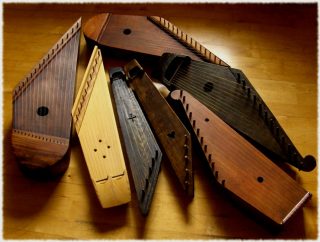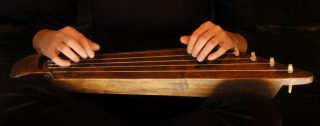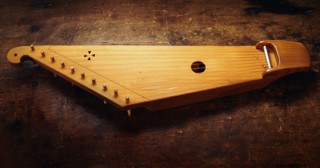A gut string kantele among others
Blog
April 10, 2023
Experimentation with string materials in small kanteles has shown interestingly how different materials affect the character of the instrument. Changing string material often requires not only a different pitch, but also a different playing technique or touch, as the feel of the strings can be completely different depending on the material.
 I have tried different types of bronze and brass wire in some museum kantele models as well as in some newer small kanteles. On the basis of museum instruments and archival information, the most common string material used in the Finnish-Karelian hollow kanteles in the 19th century was brass or bronze. The common Finnish word for both brass and bronze is vaski, which is why the instrument was often called a vaskikantele.
I have tried different types of bronze and brass wire in some museum kantele models as well as in some newer small kanteles. On the basis of museum instruments and archival information, the most common string material used in the Finnish-Karelian hollow kanteles in the 19th century was brass or bronze. The common Finnish word for both brass and bronze is vaski, which is why the instrument was often called a vaskikantele.
The pitch of the vaskikantele is lower than that of the modern steel-stringed kanteles. Depending on the construction of the instrument and the material of the strings, the pitch is usually about a third or a fourth of a fifth lower than that of an equivalent steel-stringed instrument.
Historical sources also refer to horsehair strings. The pitch of a kantele strung with horsehair is not necessarily lower than that of a kantele strung with steel strings, but the sound quality changes dramatically. The vibration of the horsehair string doesn’t last very long, so it doesn’t create the same kind of resonance and sound field as a steel-stringed (and brass- or bronze-stringed) kantele. Horsehair strings are also sensitive to changes in temperature and humidity. As a result, the tuning can change quite quickly.
Since archaeological finds indicate that vaski wire was made in Karelia from at least the 13th century, it can be assumed that horsehair was used when vaski wire was not available.
In his 1877 travelogue, Axel August Borenius mentions sinew as a string material in the kantele of a good player, Martti Tuunnainen from Anjala, Sortavala, Karelia (SKS KIA Borenia:43). So far I have seen no other reference to sinew as a kantele string material.
As gut strings were very common in historical stringed instruments, it is possible that they may also have been in use in kanteles, although there is no information to this effect. Perhaps it is possible that the sinew strings mentioned by Borenius were in fact gut strings.
I wanted to see how gut strings would sound in a kantele, and so a few years ago I ordered some from Aquila Corde Armoniche, Italy. This is the first sound sample:
The oiled smooth gut strings I ordered vary in diameter from 0.38 to 0.50.
Over 10 years ago, I tested some gut strings on a 5-string kantele replica made by Rauno Nieminen. Presumably, those strings were too thick for this particular instrument, as the resonance was non-existent and the sound quality was poor.
So I decided to order thinner strings this time. However, thicker strings might have been better for this 10-string kantele.
Especially on the higher, thinner strings, plucking harder can sometimes produce a kind of crackling sound that I personally don’t find desirable. What’s more, they don’t provide enough energy to cause the resonator to vibrate more strongly and create a greater resonance.
Otherwise, and with a lighter touch, the sound is mellow, beautiful and interesting. The feel of the instrument is very different from the steel/vaski strings, as is the quality of the sound produced. The whole character of the instrument has changed with the string material. It is not difficult to imagine this sound as medieval.
Once I had the gut strings in place, I started looking for a possible pitch and scale. The scale in the video above was formed from what we know of runosong and old kantele tune scales: no more than six scale degrees from the tonic upwards; the seventh and fifth scale degrees below the tonic, but not necessarily the sixth; plus the low octave for the tonic and possibly the low octave for the second scale degree as well. Thirds closer to Just Tuning than the Equal Temperament.
The 10-string kantele used in the experiment was made by Rauno Nieminen in the first half of the 1980s. It was the latest novelty at the time and also my first contact with this type of kanteles. Like all kanteles, it was strung with steel strings at that time.
A few years ago I tried bronze strings in this kantele and they worked quite well too.
This experiment with gut strings showed once again how the nature and the character of small kanteles change not only with the structure of the body, but also with the string material used. With gut strings, this instrument changed profoundly in both timbre and touch. Both have an impact on the musician which in turn affects the music produced.


